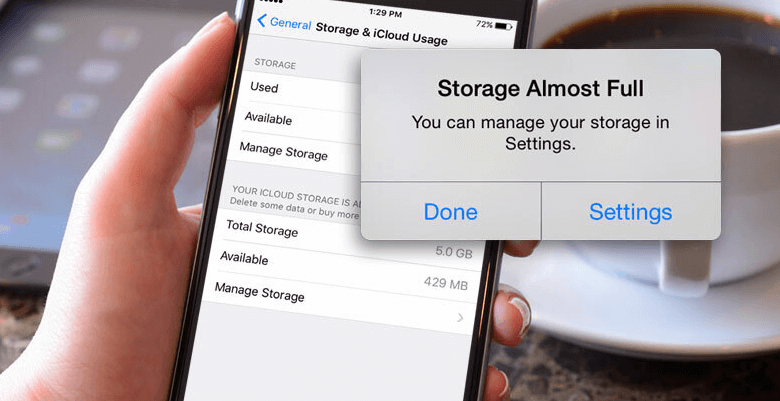How to Free Up Space on an iPhone or iPad

How to Free Up Space on an iPhone or iPad: Does your iOS device have enough storage? You can use the following method to determine what’s taking up the most space on your iPhone and iPad.
Does your iOS device still have how much space left? If you try to update your OS or download a new app, do you encounter difficulties? What is the best way to decide what to keep and what to delete? Following these few simple steps will make your iPhone or iPad less overloaded and more organized.
Check Your Total Usage
The first thing you should do is determine how much space you have. Open Settings > General > [device] Storage. There is a color-coded bar chart at the top that shows how much space various categories of apps are taking up on your device. There’s no need to get too caught up in the numbers.
You will need up to 6GB of free space to update iOS.Give yourself at least 2GB of free space so that you can download new apps and take new photos without hitting any obstacles. If you add your storage size to your available space, you will not get the total amount of storage on your phone. Due to the fact that it does not include the operating system’s space requirements.
How to Free Up Space on an iPhone or iPad
Find out which apps use the most space
These statistics can help you realize that it’s not necessarily the app that takes up space, but rather what you store within it. Using this menu, you can quickly delete podcast episodes by swiping left.
Don’t Use These Apps
You can use that device storage page to find and delete apps you don’t use. Click on the app and select Delete App. The App Store allows you to re-download any purchased app for no additional charge. The app you want to delete will disappear from the home screen if you hold your finger on it.
The icons on the apps start to wiggle and a small minus symbol appears. Click on the minus symbol to confirm deletion. On devices with a home button, press it or tap Done on the top right if you don’t have one.
Offload Them
It’s possible to offload settings so you can temporarily disable an app without deleting its settings, such as when you need to free up space for an iOS update. You’ll have to tap to re-download to get back in, but they will remain on your home screen.
Select Offload App from the storage list after finding the app in the list. It is also possible to configure your Android app to automatically remove apps you do not use often. Offload Unused Apps can be toggled on by going to Settings > App Store > Offload Unused Apps.
Review Your Photo and Video Use
People often underestimate how much space the Photos app consumes, so let’s deal directly with that app. To view how much space is being used by Photos, go to Settings > General > [device] Storage. To delete photos and videos you have stored on your device, you should copy them to a cloud storage service if you have more than 1GB.
Google Photos is an easy option if you have a Google account. Tap your account icon on the top right after you download the app, sign in, and sign in again. Toggle On Back Up & Sync under Google Photos’ Settings. You’ll then see that every photo you take on your device will be automatically backed up to Google Photos when you’re online and accessible across all your devices.
Make sure Google Photos has access to Photos (Settings > Google Photos > Photos > All Photos), so that every photo you take will be automatically backed up to Google Photos when you’re online. It used to be that Google Photos offered unlimited photo storage, but that deal is over, so plan accordingly considering that uploads to your Google account count against your storage space.
If you’ve uploaded your iPhone pics to a cloud service of your choice, double- and triple-check that they’re actually there before deleting them from Photos. If you’ve uploaded your iPhone pics to a cloud service of your choice, double- and triple-check that they’re actually there before deleting them from Photos. You can even have Google Photos delete your photos as they upload if you trust that feature.
To find them, go to Recent Deleted Albums. Then tap Select, followed by Delete All. Your iOS device will hold onto deleted photos for 30 days if you skip that final step, so you won’t be able to free up any space for one month.The lower-resolution photos you keep on your phone may be stored in iCloud; the full-resolution ones may not. Make sure the Optimize iPhone Storage box is checked in Settings > Photos.
Wade Out of the Stream
Sharing photos between iOS devices is seamless with Photo Stream. You can activate it on your Apple devices, and any pictures you take on one device will appear on others that are connected to the same Wi-Fi network, such as your iPad.
It’s a convenient feature, but Apple only allows 25,000 My Photo Stream uploads per month, so it may consume a lot of space. To turn off Photo Stream, go to Settings > Photos > My Photo Stream and toggle it off. If you do not need Photo Stream, turn it off by going to Settings > Photos > My Photo Stream.
Remove Unwanted Music
Multimedia files, such as audio tracks and videos, occupy a large amount of disk space. The Apple Music app/service offers two methods of deleting audio and video files. Click on the Settings icon > General > [device] Storage > Music. You will see a list of all the music you have on your phone at the bottom. You can delete albums or tracks you don’t listen to by swiping left. The Edit button can also be used to delete multiple tracks and albums at once.
Let’s (get rid of) the message
You should delete all messages such as “running late” and “what are you having for dinner?” to release some space. Your Messages account will be freed up even more if you regularly send videos, photos, and audio files. Make sure your texts are automatically deleted if you live a dangerous life. You can choose to keep messages for up to a year by going to Settings > Messages > Message History.
Empty the cache in your browser
The Safari web browser cache or any other mobile web browser you use may also contain some junk that you should remove from your iPhone or iPad. You can find it in Safari’s settings. Select the option to delete the history and data.
Chrome on iOS is accessed by tapping the three dots on the bottom-right corner, then selecting History. If you want to wipe all your browsing data, then tap Clear Browsing Data. If you want to wipe specific sites, tap Edit. In addition, you’ll find a Clear Browsing Data option under Settings > Privacy which allows you to erase browsing history, cookies, and site data, cached images and videos, saved passwords, and autofill data-all at once. Learn how to clear your cache on any browser by reading How to Clear Your Cache on Any Browser.



